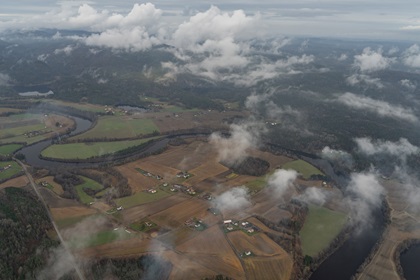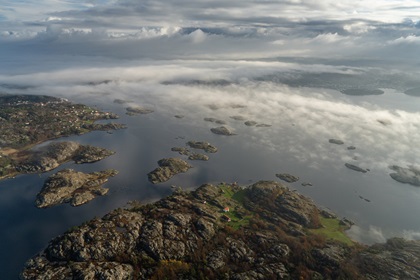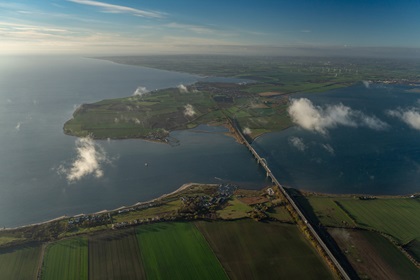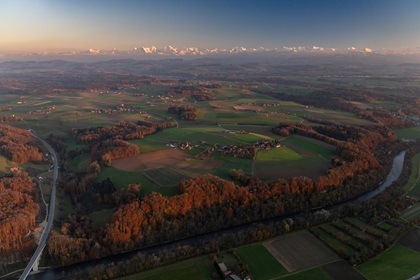Norway to Switzerland
I have wanted a second airplane for quite some time, though it took having a specific reason for it for me to spring into action.
As I wrote in “Glacial Climb” (AOPA Pilot, February 2022), the Piper PA–11 is much too slow for glacier flying and photography. Since I intend to spend the coming summer in Scandinavia, I needed something that would take less than three days to get to Scandinavia in the first place, much less navigate the distance involved from the bottom to top of Norway.
I was on a flight to Oslo three days later. The deal was made within a few hours, after a flight around the pattern in notoriously gloomy autumn weather. I contacted the insurance broker to engage coverage and, well, we sat for five days. A weekend and All Saints’ Day falling on Monday, November 1, closed the underwriting office. I was presented with no other option but to wander around Norway in a rental car, looking at sunny weather that “never happens this time of year,” while not flying south. Oslo is at 59 degrees north latitude, which is the same as Skagway, Alaska. That translates into rather short days in early November, with quite rainy and foul weather most of the time. It would be a challenge to get the aircraft out.
On the sixth day after the deal was done, I had planned to make my flight south. I woke up early, rode the train to the airport where the airplane was housed, and…waited. Low clouds were stuck over the airport until almost 1 p.m. As they finally began to clear, I figured I could get to Halmstad, Sweden, for the night. I filed my flight plan and gathered my things to leave.
That was until the an official from the Oslo flight planning office gave me a call:. “You just filed a flight plan to Sweden for departure in 20 minutes.”
“Yes.”
“You can’t do that. It must be one hour.”
“But I won’t be in Sweden for more than an hour.”
“But you can’t leave until at least one hour after you file the flight plan.”
“Then I won’t get to Sweden before dark.”
“Let me see what I can do.”
He called back, advising that, since I was not landing in Sweden near the border, Sweden requires points on the flight plan every 30 minutes into the flight. “The flight plan has a bunch of points on it,” I explained. “Let me look and call you,” he replied.
He called back. “The order of the points is in reverse. I am canceling this flight plan and you’ll have to refile.”
“Fine. This is aggravating.”
“Read the AIP.”
“For a 40-minute flight to leave the country? I talked to an instructor first and nobody mentioned any of this stuff.”
“Read the AIP.”
“I just bought the airplane and am trying to get out of here. I don’t think I should have to read a manual for a short flight.”
“You bought the airplane? Have you notified customs?”
“Why? I am leaving and it will stay on Norwegian nationality.”
“You must have clearance from customs to leave.” He gave me a number to call.
I called the number and the guy said that, since I was leaving from a domestic and not an international airport, I needed to email and get approval.
“OK, can this be done quickly?” I asked.
“You need to do it four hours before the flight.”
“Four hours? This is ridiculous!”
“Here is the email address,” he replied.

At this point, I am not sure who I talked to, though the plan was hatched to fly 20 minutes to a nearby international airport, to get around the four-hour rule. I filed two flight plans: one for the short hop to Torp, and the other to Sweden afterward, successfully avoiding the untenable advance notice requirement in the process.
After taking my first solo flight in my new purchase, I was greeted by customs, where I mentioned that I purchased the aircraft (and some Norwegian cheese). They called their superiors, for which the edict was handed down that the aircraft needed to be exported. At this point, I am tired of writing about it, so I will summarize. There was a bunch of indignant back and forth about “the aircraft staying on the Norwegian register” and some hullaballoo where I needed to get a freight forwarder to make the export declaration. Let me at this point mention that, while Norway is not part of the European Union, it is part of the European Union Aviation Safety Agency (EASA) and the European Economic Area (EEA), which means the “free movement of goods, people, services, and capital between member countries.” Forgive me for not expecting to have to clear customs to leave one country and enter another, along with making an export declaration, when there is a free trade agreement between Norway and Europe, along with “free movement of people” and the aircraft is staying on Norwegian registration.
I have to give the Norwegians credit for being helpful with anachronistic requirements. The customs agent called the sellers, got them to sign a power of attorney, and coordinated a freight forwarder. By the time it was all done 90 minutes later, it was too late to get to Sweden by nightfall, so I let the flight plan expire and went back to the same hotel. Day one: 18 miles complete, 982 to go.
I will, at this point, make reference to the concept of “read the AIP.” While waiting on flight plan acceptance, I checked the Norwegian Civil Aviation Authority’s handy quick reference guide, welcoming foreigners to fly in and visit. While it refers to landing at international airports coming into the country, it nowhere prominently stated that departure had to be from an international airport. Recall that there is no passport control inside the EEA, and it is a free trade zone. I could understand outbound control if I was flying to Russia…but I was going to Sweden. I shall note that, in the rest of the free trade and Schengen areas of Europe, this problem did not resurface.
The next day featured what appeared to be blue sky and a decent forecast, if not somewhat opaque. I took a taxi to the airport, where there was bright sun except for a fog bank hanging out on the other side of the runway. There appeared to be plenty of coastal fog here and there for the first 100 miles, before getting suitable at Gothenburg, Sweden.
I was aggravated to see that my aircraft had turned into a block of ice overnight. It was not “frost” but a half-centimeter layer of ice, which took 30 minutes to coax off the airplane. I then made haste to take off as the fog bank was now covering half of the runway. The tower approved a midfield takeoff, and I was quickly airborne and over the 200-foot fog layer, only to be greeted not with “some coastal fog” but virtually solid overcast in almost all directions. It was as though the airport was in a sliver of VFR.

Initially quite nervous, I contacted Farris Approach and got clearance for 5,000 feet. I was still making up my mind if this whole charade was entirely silly (or if I could even head back to Torp), when I could see the clouds ended 20 miles out to sea. Farris Approach confirmed VFR at Gothenburg, so I decided to fly VFR on top, over Oslofjord and some rocky coast, and get it over with. It seemed that, if I didn’t leave, I’d never get out.
Some painful distance later, overcast below gave way to partly cloudy, which then became a layer I had to dive under related to a front. Then it was hazy sunshine changing to high overcast as I flew down almost the entire west coast of Sweden to Halmstad. While the Norwegians gave me a fair dose of misery leaving, the Swedes didn’t seem to care that I arrived. Fuel was automated, and I had to search for someone to pay the landing fee. I filed for Lolland Falster in Denmark, as the weather was foul in Germany. A strong low was forming in eastern Germany, moving to the northeast, which meant good tailwinds to Denmark, but precipitation and IFR not far over the border. I opted to spend the night in Denmark, as it just seemed easier than German rules.
The flight continued down the coast then crossed the Øresund Strait southbound west of Copenhagen, out to sea a bit east of Roskilde due to special VFR in the control zone, then direct to Lolland Falster, with a strong tailwind. The strong tailwind became a strong crosswind on landing, which worked out fine given the grass strip, vortex generators, and heavier Super Cub. I was somewhat unsure given my limited hours in the PA–18, though it turned out fine.
The airport manager at Lolland Falster was surreally kind. He found space in a hangar due to rain and wind that night and drove me 15 minutes to my hotel. The next morning, he was there at 7:50 a.m. to drive me back to the airport! It felt a bit like the United States, including the little town that treated me like I had lived there for years. The similarities between parts of Scandinavia and the United States can be quite interesting.

Day three began with blue sky out the hotel window. A check of weather reports and forecasts coupled with calculating time en route implied that I could make it to Switzerland that night, given the early start! It would be good for this odyssey to come to an end.
The airport is a few miles from the shore, which meant that I was at 2,000 feet by the time I began the longest water crossing, at 12 miles. There were some scattered and broken layers that I was not in the mood to circle to climb above, so I made the crossing at a lower altitude. Without much aplomb, I was in Germany.
Northern Germany is flat, so the flight was uneventful, until about 30 miles north of Hannover. Scattered low clouds became broken, which became overcast. By the time I got to Hannover, in the thick of VFR on top (with a layer closely above) and rising tops below, the two layers merged. Illusions of getting to Frankfurt on this fuel stop were smashed, along with Switzerland for the night. I turned to the northwest, in a sea of clouds, and advised flight service I needed to divert. They came back 10 minutes later with Bremen as the most sensible VFR option (other than turning back to Denmark). I then flew one hour to the northwest, in strong headwinds, in the wrong direction.
The time it took to fuel, haggle in German to find some oil (as the top overhaul is still being broken in and I didn’t bring enough), and arrange the next flight leg bought some time needed for weather to improve in Bonn and Cologne. Until that point, it looked like the hills of the Rhine between Frankfurt and Bonn would have been the limit for the day.
I took off to the south, where I ran into occasional rain showers, lowering ceilings, marginal VFR visibility in Class G airspace, and generally terrible visibility. I found another wall south of Dortmund in the hills, so I went west to the Ruhr, Germany's industrial region, where it mysteriously was higher overcast with good visibility. The flight path was VFR on the west side of the Rhine River, with IFR on the east, and rain showers on both sides. Intuition and updated observations on the iPad indicated I could get to the other side west of Frankfurt, which I did. I had flown this part of the route in April 2016, when I went to the Netherlands and back in the PA–11.
The last part of the leg was over familiar territory: vineyards and orchards southwest of Frankfurt. It is refreshingly open terrain with lots of windmills. I had flown in this area during my brief stint moving to Germany just less than six years ago. It was interesting to revisit it, so many years later, in a different airplane.

The landing location for the night was Mannheim. It is a towered airport near the city center, which meant food, hotels, open operating hours, and English communications. I am sure a nicer little grass strip might have worked, though it can be more wrangling to get lodging and other factors in a quiet place. Sometimes a well- serviced airport hits the spot when traveling long distances.
There is a lot to say on my perspective of German and European flying in 2016 when I arrived versus that in 2021. There is not enough room to cover it here, though I will visit the subject at another time.
The next day, fog was a risk though the TAF indicated it would burn off in the morning. I was up early and had the joy, from my sixth floor hotel room, of staring at fog until 1 p.m., refusing to budge. It started to make some indications of breaking up slowly, so I checked out, rode the tram, and carted my stuff to the airport. It was still solid, though cracks were showing, so I tried to file a flight plan for departure in 40 minutes. Nope. My iPad barked “Germany requires one hour notice before departure.” What is curious is that Germany didn’t require it five years ago (or at least nobody barked when I filed for immediate departure), but so be it. I set it for one hour. For whatever it is worth, one cannot leave early with a flight plan, but they can be delayed. That reality is highly annoying. Another reality is that each European country has different notice requirements. Sweden, Denmark, Spain, Portugal, Switzerland, France, and Italy, in my experience, have no notice requirement. Norway and Germany do.
I finally took off at 3 p.m., when the fog mysteriously evaporated. I was fortunate, as it was a radius around the airport, though conditions remained quite foggy north and south. It was VFR on top down the Rhine (on the French side), for 50 miles again, where the fog was gone north of Strasbourg, France. By now, I find the French and German flight service almost indistinguishable. They do their jobs rather well. I opted for the French side of the Rhine as there were fewer frequencies to deal with.

North of Strasbourg, I realized that I would not have enough time to clear customs and get the aircraft to Saanen. I had filed for Les Eplatures in the Jura Mountains, which would mean another hotel stay. In flight, I remembered that Ecuvillens is public, so I checked the customs requirements (in French) and filled out a very long form, while flying VFR on top. I then asked flight service to change the destination. Swiss customs, like normal, did not show up. For whatever it is worth, Switzerland is in the Schengen Area (free movement of people) but not the EEA (though the country is in EASA). There is a border for goods, yet they usually do not do a formal examination. Norway is far more integrated into Europe yet has an enthusiasm for checking things.
The rest of the flight over the Rhine was a pleasant evening flight, with a hop over the clouds blocking the Jura. The Alps came into view and the flight came to a close for the day as I landed at Ecuvillens at sunset. There was not enough time to get to Saanen, so I arranged for my wife to drive to get me. I was not staying in a hotel.
The next day (day five), it was a drive back. I flew the Super Cub over Interlaken and into the Berner Oberland, a short hop over the “hill.” After landing, I pulled both airplanes out, photographed them together, put the Super Cub away, and took the PA–11 for a flight. I will only arrive with a new airplane once, so it was a chance to fly them both (and pay two landing fees) in one day. What was interesting is that, while the two aircraft are quite different, they can be quite similar in the air.
The flight took more than 14 hours, spread over five days. I bought an airplane in Norway so that, next summer, I wouldn’t have to spend “three days flying to Norway.” Well, that didn’t exactly transpire as hoped, but who cares? I finally have a Super Cub with two tanks, heat, airframe lights, and a host of other conveniences.






























